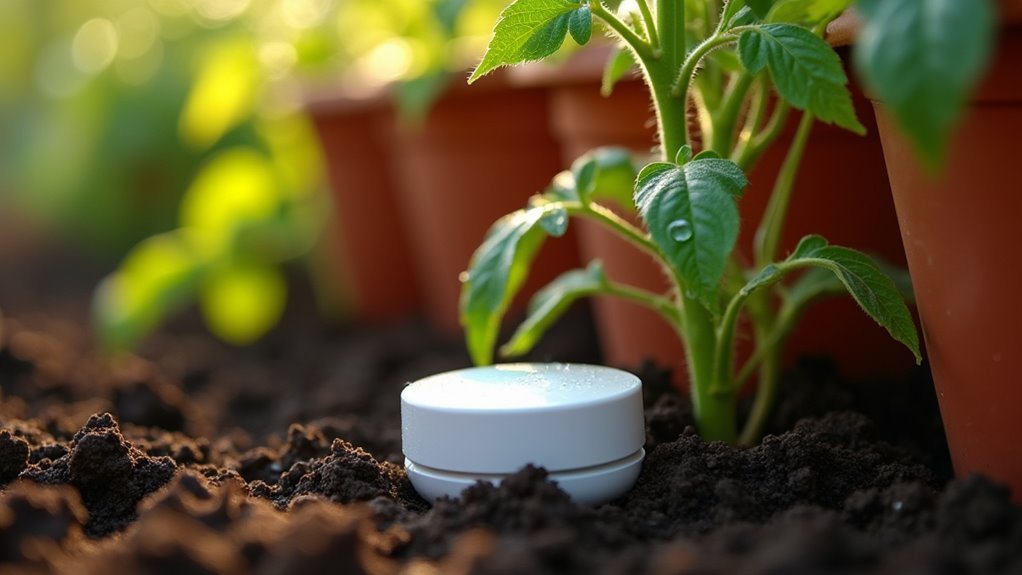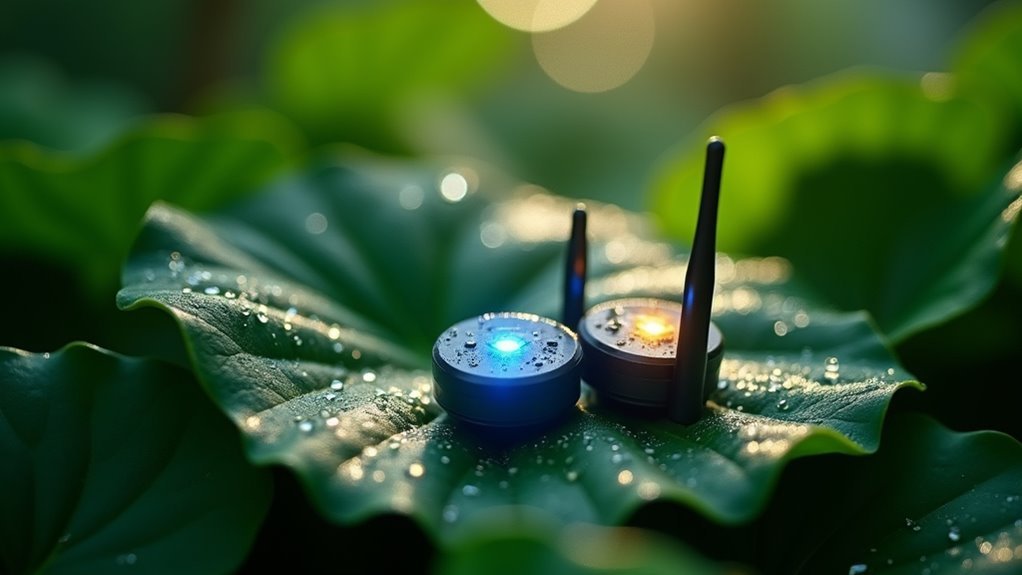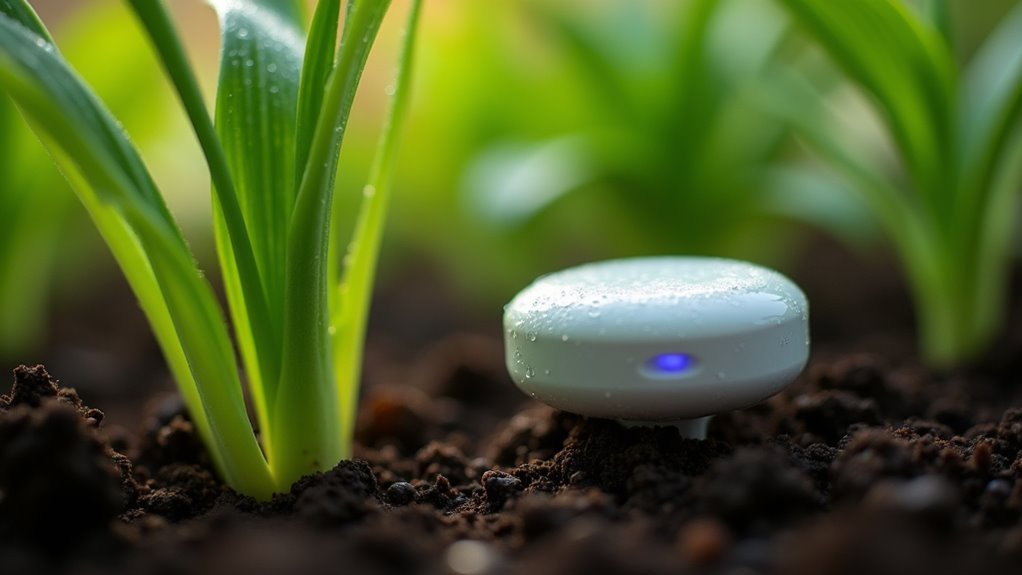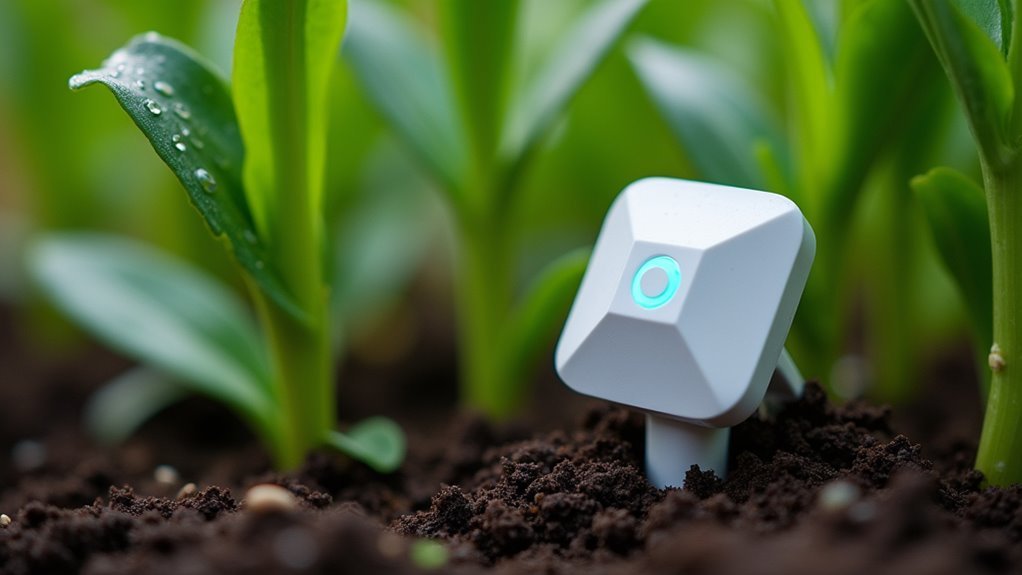You’re probably tired of guessing when your plants need water, only to discover yellowing leaves or stunted growth despite your best efforts. Wireless plant sensors eliminate this frustrating cycle by delivering precise soil moisture readings to your smartphone within seconds. These compact devices transform how you care for your garden, but choosing the right sensor technology and features can make the difference between thriving plants and expensive mistakes.
How Wireless Plant Sensors Transform Modern Gardening

While traditional gardening relies on guesswork and manual soil checks, wireless plant sensors revolutionize how you monitor and care for your plants.
These innovative devices deliver precise soil moisture readings within 72 seconds, eliminating the uncertainty that often leads to overwatering or plant stress. You’ll gain instant access to real-time data through mobile applications like WSView plus, allowing you to customize watering schedules from anywhere.
Wireless soil monitoring becomes effortless as these sensors automatically integrate live weather feeds, preventing unnecessary irrigation during rainy conditions.
Advanced models provide historical data analysis and support multiple sensors simultaneously, giving you thorough environmental insights. The user-friendly interfaces make sophisticated garden management accessible to everyone, transforming both novice and experienced gardeners into precision cultivation experts while conserving precious water resources.
Key Technologies Behind Instant Moisture Detection
Two breakthrough technologies power the instant moisture detection that makes wireless plant sensors so effective: capacitive sensing and resistive sensing methods. Your soil moisture sensor uses these technologies to deliver readings within 72 seconds, giving you immediate feedback on your plants’ water needs.
Here’s how these technologies work for you:
- Capacitive sensing measures moisture by detecting changes in the soil’s electrical field without direct contact with water.
- Resistive sensing determines moisture levels by measuring electrical resistance between two probes inserted into the soil.
- Calibration features let you customize readings for different soil types, ensuring accurate detection regardless of your garden’s composition.
These technologies connect seamlessly to your Wi-Fi network, enabling real-time monitoring through mobile applications for ultimate convenience.
Wi-Fi Vs Bluetooth Connectivity for Plant Monitoring

When you’re choosing between Wi-Fi and Bluetooth connectivity for your plant sensors, you’ll need to evaluate how far you want to monitor from and whether you prefer extended range or closer proximity access.
You’ll also find significant differences in how much battery power each option consumes, with one technology offering longer operational periods than the other.
The speed at which your sensor data transfers to your device varies considerably between these two wireless options, affecting how quickly you’ll receive real-time updates about your plants’ conditions.
Range and Coverage
Since range determines how effectively you can monitor your plants throughout your property, understanding the coverage differences between Wi-Fi and Bluetooth connectivity becomes essential for selecting the right wireless plant sensors.
Wi-Fi connectivity provides considerably broader reach, extending up to 300 feet indoors and even further outdoors. This extended range means you can place sensors anywhere on your property while maintaining constant data access.
In contrast, Bluetooth sensors limit you to approximately 30 feet, requiring close proximity for monitoring.
Consider these key range factors when choosing your system:
- Property size – Larger gardens need Wi-Fi’s extended coverage
- Sensor placement – Remote locations favor Wi-Fi connectivity
- Monitoring frequency – Constant access requires Wi-Fi’s superior range
Your monitoring needs will ultimately determine which connectivity option serves you best.
Power Consumption Differences
Battery life becomes a critical factor in your sensor selection, as Wi-Fi and Bluetooth technologies consume vastly different amounts of power during operation.
The power consumption differences between these technologies are substantial. Your Wi-Fi soil moisture meter will typically use around 0.5 watts during operation, requiring constant network connections and higher data transmission rates.
In contrast, Bluetooth sensors consume only 0.01 to 0.05 watts, making them incredibly efficient for low-frequency monitoring tasks.
This efficiency translates directly to battery longevity. You’ll find Wi-Fi sensors lasting several weeks to months before needing replacement batteries, while Bluetooth versions can operate for years.
Additionally, Wi-Fi’s higher power draw generates more heat, potentially affecting your sensor’s components over time, whereas Bluetooth’s cooler operation helps maintain long-term reliability.
Data Transfer Speed
Beyond power considerations, something equally important emerges when you’re evaluating wireless plant sensors: data transfer speed greatly affects your monitoring capabilities.
Wi-Fi connectivity delivers noticeably faster data rates than Bluetooth, guaranteeing real-time updates without frustrating delays.
Here’s why speed matters for your plant monitoring:
- Continuous monitoring – Wi-Fi’s higher bandwidth supports multiple sensors simultaneously without performance drops.
- Cloud integration – Faster speeds enable automatic uploads for historical analysis and graphing.
- Remote accessibility – You’ll access data from anywhere, unlike Bluetooth’s proximity limitations.
While Bluetooth works for basic short-range transmission, its lower bandwidth and higher latency make it less suitable for thorough monitoring systems.
When you’re serious about plant care, Wi-Fi’s superior speed guarantees your sensors deliver the responsive, reliable performance you need.
Essential Features Every Plant Sensor Should Have

When you’re investing in wireless plant sensors, moisture detection capabilities should top your priority list. Quality soil sensors deliver continuous monitoring with 1% or better resolution, detecting subtle moisture changes that keep your plants thriving.
Prioritize moisture detection with 1% resolution for continuous monitoring that catches subtle soil changes before your plants suffer.
You’ll also want temperature monitoring to track ambient conditions and prevent stress-inducing extremes.
Nutrient monitoring capabilities provide detailed soil analyses and growth recommendations, ensuring your plants receive ideal care.
Light sensing technology measures intensity, duration, and spectrum quality, helping you determine perfect plant placement based on species-specific needs.
Connectivity features like Bluetooth and Wi-Fi integration enhance your experience greatly.
You’ll access real-time data through user-friendly apps, receive personalized care instructions, and set up automated watering schedules.
These essential features transform basic monitoring into thorough plant care management.
Top Wireless Soil Moisture Sensors on the Market
With these features in mind, you’ll find several standout wireless soil moisture sensors that excel in real-world performance.
These smart soil monitors deliver precise real-time monitoring capabilities that transform your gardening approach.
Top performers include:
- WH51 Wireless Soil Moisture Meter – Provides soil moisture readings within 72 seconds and connects to the WSView plus app via WiFi for convenient monitoring.
- RainPoint Wi-Fi Soil Moisture Meter – Tracks both humidity and temperature in real-time at $29.95, though it requires a hub for operation.
- Moen Smart Sprinkler Controller – Integrates seamlessly with soil moisture sensors for smart irrigation, automatically adjusting watering schedules to reduce waste considerably.
These wireless soil moisture sensor options offer 0-100% detection ranges with 1% resolution, ensuring you’ll maintain ideal growing conditions.
Setting Up Your First Plant Monitoring System
Since you’ve identified the right wireless soil moisture sensor for your needs, it’s time to set up your first plant monitoring system.
Start by selecting a compatible sensor like the WH51 Wireless Soil Moisture Meter, which delivers readings within 72 seconds through the WSView plus app. You’ll need a gateway device such as the GW1100 or GW2000 for WiFi configuration and app connectivity.
Follow the manufacturer’s pairing instructions for simple Wi-Fi setup. Once connected, customize watering schedules and calibration settings within the app based on your specific soil types.
This guarantees ideal plant health while maximizing resource efficiency. Regularly check the app for updates and review historical data to refine your watering practices and maintain consistently healthy plants.
Mobile Apps That Revolutionize Plant Care Management
You’ll transform your gardening approach when you pair wireless sensors with mobile apps that deliver instant soil moisture readings straight to your smartphone.
These apps automate your watering schedules by analyzing real-time data and weather conditions, eliminating guesswork from plant care.
You can monitor and control up to 16 different garden zones simultaneously, making it effortless to manage diverse plants with varying water requirements.
Real-Time Data Access
Although traditional gardening required constant physical monitoring, modern wireless plant sensors paired with mobile apps transform how you manage your garden’s health.
You’ll receive real-time soil moisture data directly on your smartphone, enabling instant responses to your plants’ needs.
Apps like WSView plus deliver thorough monitoring capabilities:
- Instant updates – The WH51 Wireless Soil Moisture Meter transmits fresh data every 70 seconds
- Multi-sensor management – Monitor numerous sensors through a single gateway system
- Cross-platform compatibility – Access your data on both Android and iOS devices
You can customize watering schedules based on specific garden requirements while accessing historical data stored on cloud servers.
This remote accessibility means you’ll make informed irrigation decisions from anywhere, ensuring your plants receive ideal care without constant physical presence.
Smart Watering Automation
When you integrate smart watering automation with your wireless plant sensors, you’ll transform reactive gardening into a proactive system that waters your plants with scientific precision.
These mobile apps monitor soil moisture levels continuously, delivering real-time data visualizations and historical records that guide your irrigation decisions. You’ll enhance water usage by scheduling precise watering based on current conditions rather than guesswork.
Weather integration prevents unnecessary watering during rainfall, reducing costs and conserving water. Apps like WSView plus let you manage multiple sensors simultaneously, creating tailored strategies for different garden zones.
The user-friendly interfaces enable remote monitoring and schedule adjustments from anywhere. You’ll maintain ideal moisture levels while eliminating overwatering, ensuring your plants receive exactly what they need when they need it.
Multi-Plant Zone Management
Modern plant care apps transform gardening complexity into manageable simplicity by enabling you to oversee dozens of plants across multiple zones from a single dashboard.
You’ll receive real-time soil moisture data, temperature readings, and light measurements from wireless sensors positioned throughout your garden spaces.
These revolutionary applications offer three key management capabilities:
- Customized notifications – Set specific alerts for each plant zone based on individual watering schedules and environmental requirements.
- Family collaboration – Share access with household members to coordinate care responsibilities across larger garden areas.
- Historical analysis – Track moisture trends through graphical data representations to optimize your long-term gardening strategies.
You’re empowered to make informed decisions instantly, adjusting care protocols based on current conditions while building expertise through thorough data tracking that improves your gardening success over time.
Calibrating Sensors for Different Soil Types and Plants
Because soil composition varies dramatically between clay, sand, and loam, you’ll need to calibrate your wireless plant sensors to guarantee accurate moisture readings. Your soil meter requires custom settings for ideal performance across different conditions.
Start by adjusting the 0%AD and 100%AD values on devices like the WH51. Set your initial AD range between 70-200, with the 100%AD setting starting from 500. These baseline values accommodate varying soil compositions that greatly impact moisture accuracy.
Configure your WH51 sensor by setting 0%AD between 70-200 and 100%AD starting from 500 for optimal soil-specific calibration.
Insert your sensor completely into the soil to guarantee calibration reflects true root-zone conditions. This depth captures authentic moisture levels your plants experience daily.
Proper calibration refines your watering schedules by accounting for moisture retention differences between soil types. Clay holds water longer than sandy soil, so accurate readings prevent over-watering or drought stress, ultimately enhancing irrigation timing and plant health.
Battery Life and Power Management Strategies
You’ll need to evaluate which battery type works best for your specific sensor model, as some require single AA batteries while others need two for peak performance.
Your sensor’s power consumption directly impacts how often you’ll replace batteries, so look for models with adjustable update rates and sleep modes that can extend battery life from 6 to 12 months.
Setting up low battery alerts through your sensor’s mobile app guarantees you won’t miss critical monitoring periods due to unexpected power loss.
Battery Type Selection
Choosing the right battery type for your wireless plant sensor directly impacts both performance and operational costs.
Most wireless plant sensors operate on standard AA or AAA batteries, typically requiring 1-2 units for full functionality.
When making your battery type selection for wireless plant sensors, consider these three options:
- High-quality alkaline batteries – Provide reliable performance and are widely available, offering decent longevity for moderate usage.
- Lithium batteries – Deliver superior performance and extended life, especially in temperature-sensitive environments.
- Rechargeable batteries – Offer the most eco-friendly and cost-effective long-term solution, reducing waste while maintaining consistent power delivery.
Your choice should align with your monitoring frequency, budget considerations, and environmental preferences to maximize sensor efficiency.
Power Consumption Optimization
While selecting quality batteries sets the foundation for reliable operation, maximizing your sensor’s battery life requires strategic power management techniques.
Implementing low-power sleep mode dramatically reduces energy consumption by allowing your sensor to wake only for scheduled measurements, typically every 70 seconds. You can extend battery life further by adjusting data transmission frequency—less frequent updates mean lower energy demand.
Choose sensors with energy-efficient components and circuitry designed for power consumption enhancement. These models can deliver months or years of operation depending on your usage patterns and environmental conditions.
For continuous operation, consider solar panels or rechargeable battery systems to eliminate constant battery replacement. Regular monitoring and smart frequency adjustments will help you achieve peak battery life performance.
Low Battery Alerts
Even with optimized power management, monitoring your sensor’s battery status becomes critical for maintaining continuous operation.
Most wireless plant sensors like the WH51 provide low battery alerts through their mobile apps, ensuring you’ll know when replacement time approaches.
To maximize your sensor’s reliability, follow these essential practices:
- Check battery levels weekly through your app’s dashboard to stay ahead of power depletion.
- Enable push notifications for low battery alerts to receive immediate warnings when power drops.
- Keep spare AA batteries nearby since sensors update every 70 seconds and drain power consistently.
These low battery alerts prevent unexpected data interruptions that could compromise your plant monitoring.
Preventing Overwatering Through Smart Alerts
Smart alerts from wireless plant sensors transform how you manage watering by delivering real-time notifications when soil moisture drops below your plant’s ideal threshold.
These devices analyze moisture content with precision, like the WH51 model that measures at 1% resolution and updates every 70 seconds. You’ll receive instant alerts through mobile apps, preventing both underwatering and overwatering scenarios.
Advanced algorithms integrate weather data with soil conditions, automatically adjusting your watering schedules.
You can calibrate sensors for different soil types, ensuring accurate readings that prevent root rot from excess moisture. By setting personalized schedules based on specific plant needs and local weather patterns, you’ll eliminate guesswork.
This smart technology helps you maintain peak growing conditions while conserving water and protecting your plants’ health.
Multi-Sensor Networks for Large Garden Monitoring
When you’re managing a large garden, you’ll need a gateway hub like the GW1100 or GW2000 to coordinate multiple WH51 sensors across your property.
You can deploy up to 16 sensors strategically throughout different zones, creating a scalable network that covers varying soil types and plant requirements.
Your data integration system then compiles real-time moisture readings into a unified dashboard, letting you monitor and adjust watering schedules for each section independently.
Gateway Hub Requirements
Managing multiple wireless plant sensors across a large garden requires a central gateway hub that can handle simultaneous data collection from numerous monitoring points.
You’ll need either a GW1100 or GW2000 Smart Gateway to pair with your WH51 sensors and access their full potential through WiFi connectivity.
Your Smart Gateway system provides three essential capabilities:
- Multi-sensor support – Connect up to 16 WH51 sensors simultaneously for thorough garden monitoring.
- Real-time data access – Receive moisture updates every 70 seconds through the WSView plus app.
- Custom calibration – Adjust settings for different soil types across diverse planting zones.
The gateway hub enables historical data analysis and graphing, giving you precise irrigation management tailored to your garden’s specific needs while maintaining 1% moisture resolution accuracy.
Scalable Sensor Deployment
As your garden expands beyond a few beds, deploying multiple WH51 sensors creates a thorough monitoring network that tracks soil conditions across diverse growing zones. You can connect up to 16 sensors to a single GW1100/GW2000 gateway, eliminating complex wiring while providing extensive coverage.
| Zone Type | Sensor Placement | Soil Monitoring Benefits |
|---|---|---|
| Vegetable Beds | Every 10-15 feet | Targeted watering schedules |
| Flower Gardens | Zone perimeters | Moisture variation tracking |
| Fruit Trees | Root zone areas | Deep soil analysis |
| Greenhouse | Multiple heights | Climate-specific monitoring |
| Slopes/Hills | Strategic intervals | Drainage pattern assessment |
Strategic placement accounts for varying soil types, sunlight exposure, and irrigation needs. Live weather data integration adjusts watering automatically based on real-time conditions. Historical data uploads to Ecowitt’s server enable long-term analysis for optimized plant care decisions.
Data Integration Systems
Beyond individual sensor placement, sophisticated data integration systems transform your multi-sensor network into a unified monitoring platform that coordinates information from all 16 possible WH51 sensors simultaneously.
You’ll access extensive moisture and temperature readings through a centralized mobile app that processes real-time data from every zone in your garden.
These systems deliver three essential capabilities:
- Historical trend analysis – Track moisture patterns over weeks and months to identify ideal watering cycles
- Live weather integration – Automatically adjust irrigation schedules based on incoming precipitation forecasts
- Family collaboration tools – Share sensor data with household members for coordinated garden management
Your data integration systems prevent overwatering by analyzing environmental conditions and customizing irrigation schedules, ensuring each plant receives precisely the moisture it needs when it needs it.
Cost Analysis: Manual Vs Automated Plant Care
When you’re weighing the costs between manual and automated plant care, the numbers tell a compelling story that extends far beyond the initial price tag.
While manual soil monitoring tools accumulate expenses over time, a wireless plant sensor like the WH51 costs just $17.99 and delivers long-term savings through efficient water usage. You’ll reduce water waste by up to 30% with real-time data that eliminates subjective guesswork leading to overwatering or underwatering.
The precision matters—automated sensors monitor moisture levels from 0% to 100%, achieving accuracy manual methods can’t match.
This enhanced plant health reduces disease risk while cutting overall maintenance costs by 20%. You’ll also save valuable time by eliminating frequent manual checks, creating opportunity for other gardening tasks.
Troubleshooting Common Wireless Sensor Issues
While wireless plant sensors offer significant cost savings and accuracy advantages, you’ll occasionally encounter technical hiccups that can disrupt your automated monitoring system.
Even the most advanced wireless plant sensors can experience occasional technical issues that interrupt your automated garden monitoring workflow.
When your irrigation schedule depends on accurate soil moisture data, these issues need quick resolution.
Here are three essential troubleshooting steps:
- Check connectivity – Confirm your sensor’s paired correctly with the gateway hub and verify Wi-Fi stability within range to prevent data transmission failures.
- Verify power and placement – Confirm the battery’s properly installed with sufficient charge, and ascertain the sensor’s fully inserted into soil for accurate readings.
- Calibrate regularly – Follow manual instructions to calibrate your sensor for different soil types, maintaining precision in your automated irrigation system’s decision-making process.
Advanced Features: Temperature and Light Integration
As wireless plant sensor technology evolves, manufacturers have integrated sophisticated environmental monitoring capabilities that extend far beyond basic soil moisture detection.
You’ll find modern sensors like the FYTA Beam incorporating temperature monitoring that tracks both soil and ambient conditions, giving you precise insights into your plants’ growing environment.
These advanced devices also feature light sensing technology that measures intensity and duration, helping you identify ideal placements for different species based on their specific requirements.
Through wireless connectivity, you’ll receive real-time updates about temperature and light conditions via intuitive mobile apps.
This extensive data integration helps you prevent heat stress and inadequate sunlight exposure, ultimately promoting healthier, more productive plants through informed care decisions.
Frequently Asked Questions
Why Does My Moisture Meter Read Dry After Watering?
Your moisture meter reads dry after watering because water hasn’t penetrated deep enough, your soil’s compacted, the sensor needs calibration, you’ve overwatered creating waterlogged conditions, or it’s positioned too shallow.
Is There a Plant Moisture Meter That Actually Works?
You’ll find the WH51 Wireless Soil Moisture Meter actually works reliably. It’s got 4.82/5.0 customer ratings, 1% precision, calibrates for different soils, and delivers real-time data within 72 seconds.
How Do You Monitor Plant Moisture?
You can monitor plant moisture by inserting your finger into soil, using analog moisture meters, or installing wireless sensors that connect to your phone for real-time readings and data tracking.
What Sensors Monitor Soil Moisture?
You can use wireless soil moisture sensors like the WH51 Wireless Soil Moisture Meter or RainPoint Wi-Fi models. These sensors connect through gateways, provide accurate readings within seconds, and monitor multiple locations simultaneously.





Leave a Reply